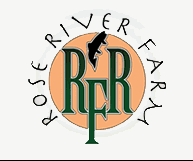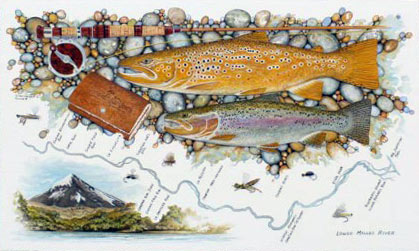Brown Trout, August 2012, Fish of the Month!
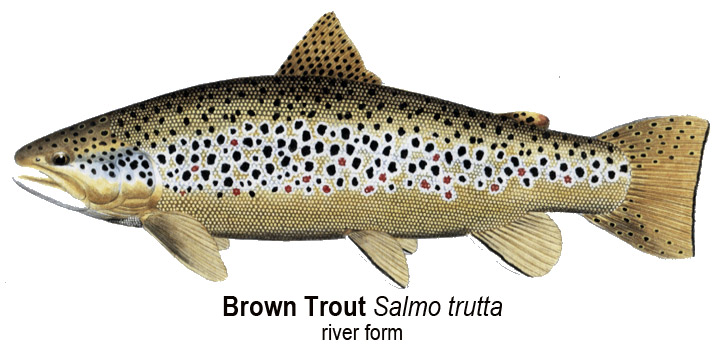
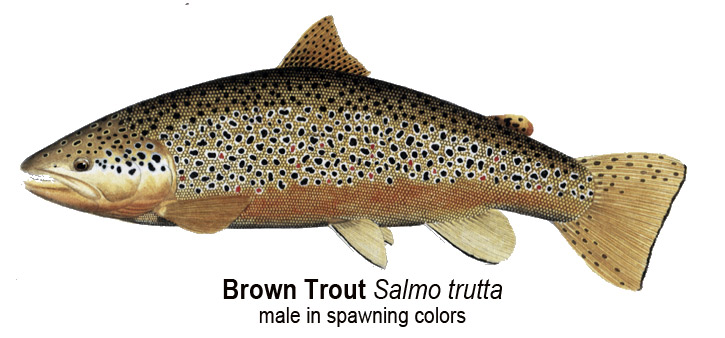
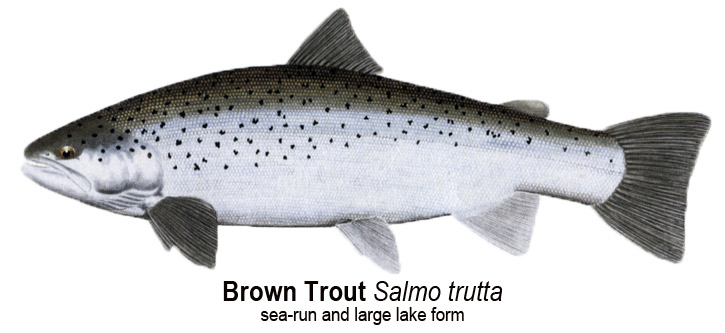 Brown Trout
Brown Trout
Salmo trutta
Local Names:
Brown, Brownie, German Brown, Loch Leven Brown,
Von Behr trout, Sea trout, Sea-run Brown, Salter
Average Size:
10 to 18 inches
1/2 to 2 pounds
Distinguishing Field Marks:
Color and color pattern are reliable distinguishing field marks for this species. (See the illustration.)
-
Brown trout have a large mouth, with its upper jaw extending well beyond the rear edge of the eye.
-
Color is extremely variable, depending on the individual's age and habitat (see accompanying illustrations). The back, sides, and head are usually moderately to heavily marked with irregularly-shaped black and often red or orange spots. Spots on the gill covers are often quite large and are sometimes haloed in blue while the spots on the sides may be haloed in white. The dorsal and adipose fins are spotted. The adipose fin is usually bordered in reddish-orange. The tail fin may or may not be spotted.
-
Young Brown trout have slightly forked tail fins.
-
The tails of adult females may be very slightly curved on their trailing edge or nearly straight.
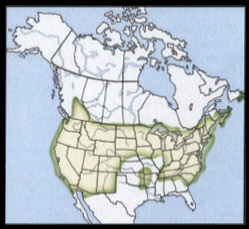
-
Tails of adult males may be straight or slightly rounded on their trailing edge.
-
The anal fins of adult females are nearly triangular, those of males are rounded.
-
Brown trout anal fins have 10 to 12 rays.
-
Adult Brown trout are often deep-bodied, and their caudal peduncles are thick, providing no easy hand grip.
North American Range:
Map to the right shows approximate range in North America.
Diet:
Young Brown trout consume the standard in-stream diet of zooplankton that the current washes to them. As they grow, their diet changes to one of immature and adult aquatic and terrestrial insects and other invertebrates taken on the bottom, suspended in the water column, or at the surface.
At about 12 inches long, Brown trout begin to develop their preference for a diet of fish, including other Brown trout. At this stage, they are omnivorous and will take anything that comes into their feeding lanes, although very large Browns focus mainly on the larger meals.
Adult Brown trout are formidable predators, which can result in there being a few large dominant Browns in a given water.
Fly Fishing for Brown Trout:
Brown trout, the benchmark for European and British trout, are not native to North America. They have, however, been so widely stocked (see range map) across this continent that nearly any water capable of supporting trout of any species will have at least a section where Browns are predominant. They were introduced to this continent to provide trout fishing in waters that had become unsuitable for native Brook trout. Brown trout are able to thrive in less pristine and warmer waters than that tolerated by Brook trout.
When Brown trout were introduced to North America, many sportsmen complained that they were much harder to catch than the native Brook trout; and this is generally true, but, out of their wariness and "selectiveness" grew a quiet revolution in American fly fishing. Based in the now fabled streams of the Catskill Mountains of New York, sometimes still known as "the cradle of American fly fishing," evolved a tradition of carefully studying the insect life of the stream and tying fly patterns to imitate these. Because early observers of aquatic insect life had no access to underwater photography or other recent developments in angling-related technology, their studies were primarily of the observable adult stages of various insect species, hence the evolution of the dry fly and all its attendant methods of presentation. This aspect of American angling history is another that is well worth studying for those who are interested in deepening their appreciation of its depth and romance. A good place to start this might be to look into the contributions of Theodore Gordon, and work forward in time from there.
The list of flies that will take Brown trout is as long as the waters in which these fish live. From tiny midges to large streamers, the choice is yours, based on the local forage base.
All that said, fly fishers seeking Brown trout can find them throughout their wide North American range (see map) in all types of waters, from small, clear, cool headwater tributaries to large lakes and brackish coastal estuaries. They will come to as wide a variety of artificial flies as any angler could hope to explore. The variety of habitats in which Brown trout can be found will provide you opportunities to use anything from 2 to 8 weight line systems in their pursuit.
Sea-or lake-run populations of Brown trout are most available to anglers as they enter rivers in late summer or fall in advance of their late winter spawnings. At this time, they are at the peak of their strength and full of energy, resulting from their recent life in expansive, forage rich waters. These lake or sea-run trout are usually quite large and capable of putting up long, arm-tiring battles. One might think that catching them at this point would be pretty easy. Not so; Anadromous Brown trout, like their cousins the sea-run Atlantic salmon, tend to be quite "fussy" about what flies they will take, and when they will take them. Finding the fish and devoting the time to understanding them is the order of the day.
When hooked, Brown trout are not as acrobatic as Steelhead or Atlantic salmon. Rather, they tend to more "bull-dogging" tactics as they struggle to free themselves. They will occasionally clear the water, but not often by much. Browns, especially the larger ones, will make strong runs in the direction of any line-tangling or line-cutting structure available to them, and if they reach that, it will usually be the end of your encounter.
Status:
Healthy and maintaining. Many populations are augmented, and some are maintained, by annual stocking. Brown trout are a hardy species, and do well in most habitats, often establishing naturally reproduced wild populations.


